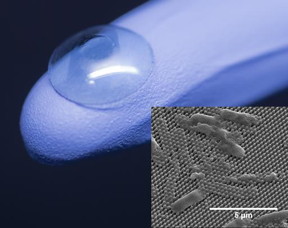Science
Pumping up energy storage with metal oxides

This schematic illustration shows metal oxides tented inside graphene. Many metal oxide/graphene composites offer unexpected capacity synergy that helps to increase storage capacity.
- Read more
- 343 reads
Iranian Scientists Synthesize Nanocomposite Surfaces to Eliminate Air Polluting Gases

- Read more
- 340 reads
UGA researchers find potential treatment for prostate cancer

Somanath Shenoy is an associate professor of Clinical and Experimental Therapeutics in the University of Georgia College of Pharmacy.
- Read more
- 396 reads
Could bread mold build a better rechargeable battery?

This is an artistic rendering of a carbonized fungal biomass-manganese oxide mineral composite (MycMnOx/C) can be applied as a novel electrochemical material in energy storage devices
- Read more
- 441 reads
New technique for rapidly killing bacteria using tiny gold disks and light: Research team from University of Houston find that the light-activated gold nanoparticles destroy potentially deadly bacterial cells in seconds

This is an artist's interpretation of how bacteria cells on a nanoporous gold disk array are killed after exposure to near-infrared light.
- Read more
- 384 reads
Launch, Docking Returns International Space Station Crew to Full Strength

The Soyuz TMA-20M rocket launches from the Baikonur Cosmodrome in Kazakhstan on Saturday, March 19, 2016 carrying Expedition 47 Soyuz Commander Alexey Ovchinin of the Russian space agency Roscosmos, Flight Engineer Jeff Williams of NASA, and Flight Engineer Oleg Skripochka of Roscosmos into orbit to begin their five and a half month mission on the International Space Station.
- Read more
- 377 reads
A 'Tail' of Two Comets

Comet 252P/LINEAR will safely fly past Earth on March 21, 2016, at a range of about 3.3 million miles (5.2 million kilometers). The following day, comet P/2016 BA14 will safely fly by our planet at a distance of about 2.2 million miles (3.5 million kilometers).
- Read more
- 376 reads
New research shows how nanowires can be formed
Nanowires are believed to be important elements in several different areas, such as in future generations of transistors, energy efficient light emitting diodes (LEDs) and solar cells.
- Read more
- 341 reads
Insect wings inspire antibacterial surfaces for corneal transplants, other medical devices

The center of an artificial cornea (on glove) is coated with tiny pillars that impale and kill bacterial cells (inset).
- Read more
- 500 reads
Human Rights
Fostering a More Humane World: The 28th Eurasian Economic Summi

Conscience, Hope, and Action: Keys to Global Peace and Sustainability

Ringing FOWPAL’s Peace Bell for the World:Nobel Peace Prize Laureates’ Visions and Actions

Protecting the World’s Cultural Diversity for a Sustainable Future

Puppet Show I International Friendship Day 2020


